| 3.1.1 Before packing a CTU, careful consideration should be given as to how the unit will be presented during the packing operation. The same applies for unpacking. The CTU may be presented for packing or unpacking as follows: |
|
| - | loaded on a semi-trailer chassis together with a truck; |
| - | loaded on a semi-trailer chassis, but without a truck; |
| - | loaded on a rigid truck or chassis; |
| - | standing on the ground; |
| - | standing on its supporting legs (in case of class C swap-bodies); |
| - | loaded on a rail-car; |
| - | loaded on an inland barge; or |
| - | loaded on a seagoing vessel. |
- Any of these configurations is possible. The actual packing or unpacking situation often depends on site and facility considerations. However, whenever the CTU is presented on a chassis or on supporting legs, special care should be taken in planning the packing or unpacking operation.
-
3.1.2 A CTU to be packed should rest on level and firm ground or on a trailer or a rail-car. If a CTU is on a trailer, care should be taken to ensure the trailer cannot tip while the container is being packed, especially if a lift truck is being used. If necessary, the trailer should be propped. Brakes should be securely applied and the wheels chocked.
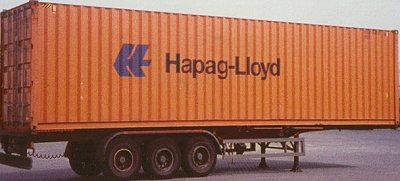 |
|
| 40' high cube container loaded on a chassis |
The support legs of the chassis are designed in such a way that they can carry the total permissible weight of the load or their own maximum payload. However, the support legs are unable to bear additional forces which would arise e.g. by driving into a container of this kind with a fork-lift truck.
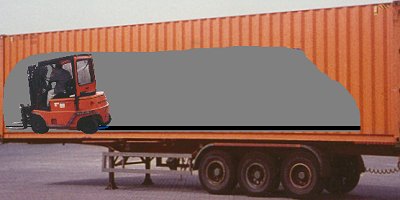 |
|
| Risk of accident: Inadequate support |
The CTU guidelines also provide a warning regarding inadequate support of semi-trailers.
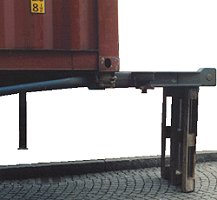 |
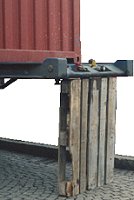 |
|
| Dangerously inadequate support of a chassis | ||
There is a very great risk of the pallet collapsing at the slightest horizontal movement of the semi-trailer. During loading and unloading, the position of the loading area in relation to the horizontal plane changes, because the vehicle rides up and down on the suspension.
 |
Correctly supported chassis |
 |
|
| Correctly supported chassis - detail |
Thanks to the wheels and the handles, the support can be moved without a vast amount of effort. The wheels are effectively deactivated when the support is loaded against the spring and reactivated when the load is relieved.
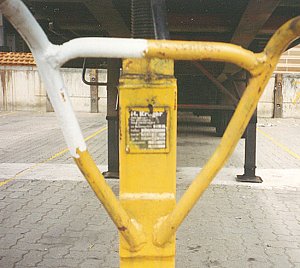 |
Adjustable-height support - detail view |
Approved supports are inspected and bear an appropriate approval plate with the necessary data on their permissible loading capacity.
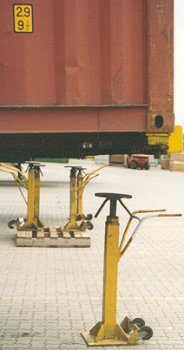 |
This is a genuine picture | |
For reasons already given, the height of the chassis changes with the container during handling. The supports must therefore be regularly checked and adjusted. Any continuation of work under these conditions would represent a breach of regulations.
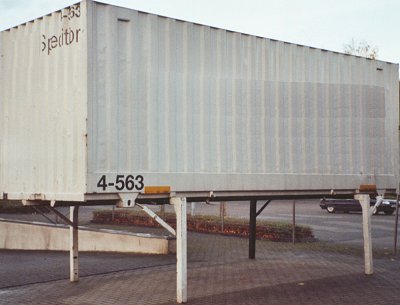 |
|
| A swap-body standing on its support legs |
- 3.1.3 When a swap-body standing on its supporting legs is packed, particular care should be taken to ensure that the swap-body does not tip when a lift truck is used for packing. It should be checked that the supporting legs of the swap-body rest firmly on the ground and cannot shift, slump or move when forces are exerted on the swap-body during packing.
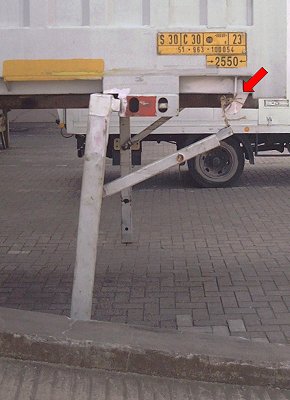 |
Potentially lethal negligence |
Before driving onto a swap-body, it should always be checked that the supports are sound and are securely fastened. Here, not only is one "leg" deformed, but the diagonal support is even fastened with "ropes"!
The relevant German trade association also demands:
-
The employer may only use ground conveyors for driving onto containers and vehicles if no dangerous concentrations of health-threatening exhaust gas substances can be produced in the inhaled air.
For information on securing the vehicle to be loaded or unloaded against unintentional movement, see Section 37 Para 2 of the German Accident Prevention Guidelines (UVV) for vehicles.